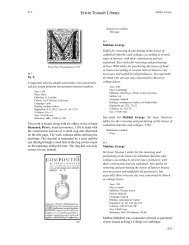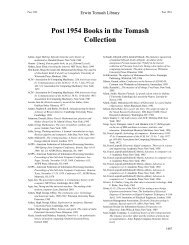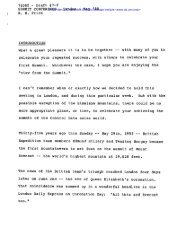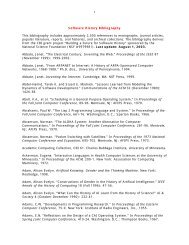B chapter.indd - Charles Babbage Institute - University of Minnesota
B chapter.indd - Charles Babbage Institute - University of Minnesota
B chapter.indd - Charles Babbage Institute - University of Minnesota
Create successful ePaper yourself
Turn your PDF publications into a flip-book with our unique Google optimized e-Paper software.
Erwin Tomash Library<br />
Berkeley, Edmund Callis Berkeley, Edmund Callis<br />
devised and sold several relay computers and small<br />
robots (Simon, Squee, Relay Moe, etc.) as educational<br />
projects in kit form.<br />
This work covers Boolean algebra and how it can be<br />
used to describe circuits composed <strong>of</strong> tubes, relays, delay<br />
lines and other devices.<br />
Illustrations available:<br />
Title page<br />
B 138<br />
[Berkeley, Edmund Callis (1909–1988)]<br />
Geniacs: Simple electronic brain machines, and how<br />
to make them. Also: manual for Geniac electric brain<br />
construction kit No. 1.<br />
Year: 1955<br />
Place: New Haven<br />
Publisher: Oliver Garfield<br />
Edition: 1st<br />
Language: English<br />
Binding: original paper wrappers<br />
Pagination: pp. 64<br />
Size: 215x140 mm<br />
In 1950, Berkeley Associates produced a small<br />
educational computer known as Simon intended to teach<br />
the basic principles <strong>of</strong> switching circuits. Because the<br />
parts for Simon cost $300, it was decided to market it as<br />
a kit. This report is the manual for the resulting Geniac<br />
kit, which by 1955 sold for only $20. With it you could<br />
produce a number <strong>of</strong> ultra-simple devices ranging from<br />
a doorbell to a machine for converting from binary to<br />
decimal. The introduction states that<br />
We have had great help from several outstanding<br />
computer men in the design <strong>of</strong> about one third<br />
<strong>of</strong> the Geniac circuits … and regret that they feel<br />
they have to remain anonymous.<br />
Illustrations available:<br />
Cover page<br />
B 139<br />
Berkeley, Edmund Callis (1909–1988)<br />
Giant brains or machines that think.<br />
Year: 1949<br />
Place: New York<br />
Publisher: John Wiley<br />
Edition: 1st<br />
Language: English<br />
Binding: original cloth boards; with dust jacket<br />
Pagination: pp. xvi, 270<br />
Size: 212x138 mm<br />
Reference: Ran ODC, p. 407<br />
B 138<br />
This volume was one <strong>of</strong> the first to popularize computers<br />
and was a major reason for the association <strong>of</strong> brain with<br />
computer. It covers all the major machines <strong>of</strong> those years<br />
(differential analyzers, punched card machines, Aiken’s<br />
machines, Bell Labs machines, ENIAC, etc.) and<br />
speculates on what the future would bring. The book was<br />
overly optimistic as to exactly what computers would<br />
shortly be able to accomplish, but Berkeley insisted all<br />
his life that he was correct and that it just would take<br />
a little longer. He published fourteen other books and<br />
continued to publish his Computers and Automation<br />
(later renamed Computers and People) until his death.<br />
In later life Berkeley became more interested in people<br />
and anti-nuclear causes. Portents <strong>of</strong> this shift in interests<br />
can be seen from the fact that the last <strong>chapter</strong>s <strong>of</strong> this<br />
book are devoted to social issues. In 1972, ACM honored<br />
Berkeley as its founder at its 25th Anniversary Dinner.<br />
His acceptance speech was a direct denunciation <strong>of</strong> those<br />
in computing who worked on the killing devices used in<br />
the Vietnam war, <strong>of</strong> computing companies that built such<br />
horrors, and <strong>of</strong> ACM for ignoring this immorality. He<br />
said that it was a gross neglect <strong>of</strong> responsibility that ACM<br />
was not investigating whether computer applications<br />
were good or evil and how computers could be used to<br />
increase the good <strong>of</strong> society. Several prominent ACM<br />
members, employees <strong>of</strong> the firms and government<br />
agencies that Berkeley had identified, ostentatiously<br />
walked out <strong>of</strong> the banquet room while he was speaking.<br />
133







